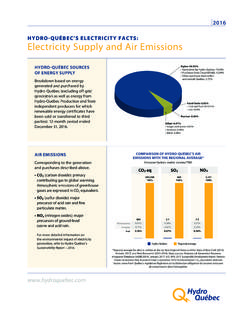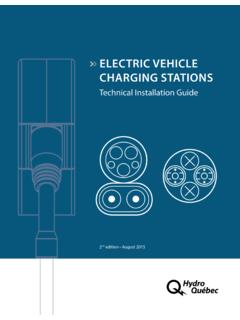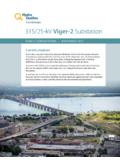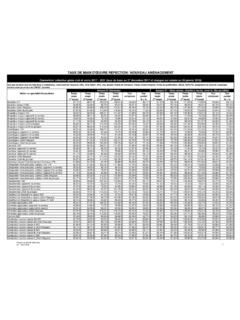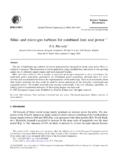Transcription of Renewable energy option. Photovoltaic solar power
1 A Renewable energy OPTION. Photovoltaic solar . power . 2. A R E NE WA BLE E NE R GY O PT IO N PH OTOVOLTAIC S O L A R P O WER. THE energy OF THE SUN. Photovoltaic systems connected to a power grid represent CURRENT STATE OF KNOWLEDGE 95% of the current market , with off-grid systems representing The Photovoltaic industry has made considerable progress the remaining 5%. in the last decade. Its installed capacity shot from 1,790 MW to In Qu bec, centralized Photovoltaic solar power genera- 137,000 MW between 2001 and 2013, an average increase of tion is in the experimental stage. While distributed generation Photovoltaic .
2 40% per year. In 2013, Photovoltaic solar power accounted for does exist, it is still very rare. solar power : about 1% of the world's total electricity output and 4% of the energy FROM available installed capacity. SUNLIGHT, CONVERTED Photovoltaic solar POTENTIAL . DIRECTLY INTO The availability of solar energy varies: the amount of sunshine ELECTRICITY BY MEANS depends on the time of day, weather and season, and it can OF A Photovoltaic be difficult to predict. Daily sunshine levels in Canada also vary by region. In Qu bec, solar energy is unavailable during COLLECTOR. peak demand periods (mornings and evenings) in the winter.
3 As a result, Photovoltaic systems must be adapted to the wide swing in sunlight levels we experience between the summer and winter, especially in northern Qu bec. This fluctuating availability of solar energy has a number of technical repercussions for Photovoltaic systems connected to Qu bec's transmission system, especially if the total or local installed capacity becomes significant. Ultimately, these tech- nical constraints will have an impact on the choice of power generation system, in light of the costs involved. In southern Qu bec, where most of the population is con- centrated, the average annual load factor for Photovoltaic sys- tems is close to 16% or 17%.
4 That is higher than in Germany Cover: Ground-mounted photo- and Japan, even though they are the leaders in the global pho- voltaic panels tovoltaic solar power industry. Opposite: Photovoltaic panels on the roof of a house 3. A R E NE WA BLE E NE R GY O PT IO N PH OTOVOLTAIC S O L A R P O WER. + LEARN MORE. OUTPUT AND COSTS. In 2014, energy conversion efficiency for Photovoltaic modules SUSTAINABLE DEVELOPMENT. The main issues for large-scale Photovoltaic systems are the The Photovoltaic effect used in electrical microgrids averaged 15%. The efficiency rate following: Types of technologies for multijunction cells exceeded 40%, but their production cost [[ Visual impact: number of units, size, color and light reflection solar power generation is still too high for large-scale use.]]
5 Photovoltaic technologies methods have varying levels of sensitivity to temperature, and as a result [[ No noise Intermittent sunshine their efficiency and output for a given level of sunshine (insola- [[ Obstacle to rain runoff and partial soil sealing (depending Daily insolation tion) can vary by up to 30% between summer and winter. on system foundation). Average costs The main obstacle to the growth of Photovoltaic solar Systems and networks power remains the upfront costs. Over the last decade, an en- [[ Use of large quantities of water for cooling and cleaning Climate change and air tire industry has sprung up thanks to generous development purposes, production of wastewater quality incentives, especially for systems connected to power grids.]]]]]]
6 In [[ Increased risks of soil degradation, including erosion Life cycle assessment recent years, however, costs have come down considerably. Ecosystems and In Qu bec, the current upfront costs (2014) for small photo- [[ Impact on natural habitats and disruption to wildlife biodiversity voltaic systems connected to a power grid are still higher than for [[ Possible conflicts: farmland, access roads, woodlands and Health and quality of wind power or hydroelectric projects (Hydro-Qu bec projects). life built environments (impact on property values). Land use [[ Use of toxins during manufacturing ADVANTAGES AND DISADVANTAGES.]]]]]]]]
7 Regional economy [[ Zero greenhouse gas and atmospheric contaminant emis- Social acceptability [[ Intermittent output that varies depending on the time of sions during operation day, weather and season and can be difficult to predict [[ Small environmental impact over the facility's life cycle [[ Output optimized through the use of energy storage systems [[ No moving parts [[ Variable size and scalable or modular design (with modules added as required), making it possible to increase installed capacity [[ Reliability and long service life (about 30 years). [[ Little maintenance required and low operating costs [[ High site potential (buildings, parking lot sun shades, open spaces, etc.)]]]]]]]]]]]]]]]]]]
8 [[ Ground-mounted systems requiring considerable space 4. A R E NE WA BLE E NE R GY O PT IO N PH OTOVOLTAIC S O L A R P O WER. A SUSTAINABLE RESOURCE. The Photovoltaic effect The Photovoltaic effect is the direct conversion of photons (sunlight) into electric current by means of a semiconduct- ing material. Most existing Photovoltaic collectors, based on ELECTRICITY. GENERATION. monocrystalline or polycrystalline silicon, come in the form of panels that are laid on the roofs of houses or other buildings. Photovoltaic solar cells use the Photovoltaic effect to con- vert sunlight directly into electricity.]]
9 A Photovoltaic system consists of an array of cells arranged in panels that are con- nected in series, in parallel or by both methods. Negative electrode Type of technologies (front contact). There are a range of Photovoltaic technologies, and they have Silicon reached different levels of development. Boundary layer Photovoltaic panels + + Silicon [[ Crystalline silicon thin slices cut from a silicon crystal (in the case of monocrystalline silicon) or from a block of + + +. silicon crystals (polycrystalline silicon). The main types of + crystalline cells in use are monocrystalline, polycrystalline and ribbon silicon.]]
10 Their manufacture requires a significant Positive electrode amount of energy and raw materials. (rear contact). [[ Thin-film thin layers of a photosensitive material laid on a substrate (glass, stainless steel or plastic). The main types of materials used are amorphous silicon, cadmium 5. A R E NE WA BLE E NE R GY O PT IO N PH OTOVOLTAIC S O L A R P O WER. t elluride, copper indium diselenide and copper-indium- Other solar power gallium- selenium. Their manufacture requires less energy generation methods and raw material. [[ Passive solar the building's orientation and its window [[ Flexible cells created by depositing an active material placement and size, along with thermal walls and elec- on a thin plastic substrate, making the entire assembly trochromic windows, are designed to take maximum ad- flexible.]]]]]]

